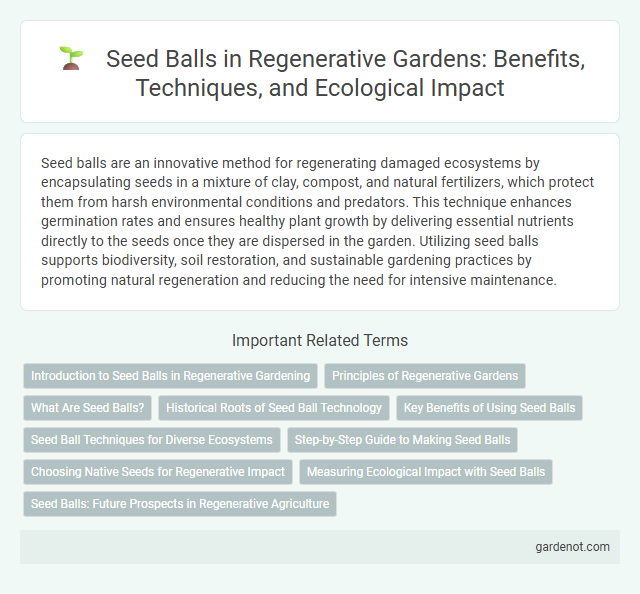Seed balls are an innovative method for regenerating damaged ecosystems by encapsulating seeds in a mixture of clay, compost, and natural fertilizers, which protect them from harsh environmental conditions and predators. This technique enhances germination rates and ensures healthy plant growth by delivering essential nutrients directly to the seeds once they are dispersed in the garden. Utilizing seed balls supports biodiversity, soil restoration, and sustainable gardening practices by promoting natural regeneration and reducing the need for intensive maintenance.
Introduction to Seed Balls in Regenerative Gardening
Seed balls are a vital tool in regenerative gardening, consisting of a mixture of clay, compost, and native seeds designed to promote sustainable plant growth. These encapsulated seeds protect against pests and harsh weather, increasing germination rates in degraded or hard-to-reach areas. Utilizing seed balls enhances soil health, biodiversity, and ecosystem restoration by facilitating natural vegetation regeneration.
Principles of Regenerative Gardens
Seed balls embody key principles of regenerative gardens by enhancing soil health, promoting biodiversity, and facilitating natural plant propagation. These nutrient-rich spheres protect seeds from environmental stressors and pests, improving germination rates without chemical inputs. By enabling native plant growth in disturbed or degraded areas, seed balls support ecosystem restoration and long-term landscape resilience.
What Are Seed Balls?
Seed balls are compact clusters of seeds encased in a mixture of clay, compost, and natural binders designed to protect seeds from harsh environmental conditions and predators. They facilitate easy and efficient planting, allowing seeds to germinate when conditions become favorable, promoting biodiversity and soil health in regenerative gardens. Often used in reforestation and habitat restoration, seed balls enable widespread seed dispersal without disturbing the soil deeply.
Historical Roots of Seed Ball Technology
Seed ball technology traces back to ancient civilizations in Japan and Africa, where indigenous farmers used seed balls to regenerate barren lands and promote sustainable agriculture. This method involves encasing seeds in a protective mixture of clay and compost, allowing them to withstand harsh environmental conditions and improve germination rates. Modern regenerative gardening practices have adopted this technique to restore soil health and enhance biodiversity by facilitating natural plant growth in degraded ecosystems.
Key Benefits of Using Seed Balls
Seed balls enhance soil health by introducing diverse native plant species that improve biodiversity and prevent erosion. They facilitate efficient planting in hard-to-reach or degraded areas, promoting natural regeneration with minimal human intervention. The protective coating of seed balls safeguards seeds from predators and harsh environmental conditions, increasing germination rates and overall plant survival.
Seed Ball Techniques for Diverse Ecosystems
Seed ball techniques involve encasing native seeds in a mixture of clay, compost, and water to protect them from predators and harsh environmental conditions, promoting successful germination across diverse ecosystems. This method facilitates reforestation and habitat restoration by enabling seed dispersal in areas with limited soil disturbance and varying climates. Incorporating seeds from multiple native plant species enhances biodiversity, supporting resilient and self-sustaining regenerative gardens.
Step-by-Step Guide to Making Seed Balls
Start by mixing one part clay powder with five parts of a high-quality seed mix and five parts of screened compost to form a moist, dough-like consistency. Roll the mixture into small balls about 1 inch in diameter, then place them on a tray to dry in a warm, shaded area for 24 to 48 hours until hardened. Once dry, scatter seed balls over bare soil to promote native plant growth and improve soil health in any regenerative garden setting.
Choosing Native Seeds for Regenerative Impact
Choosing native seeds for seed balls significantly enhances soil health and supports local pollinators, fostering a resilient ecosystem. Native plants, adapted to regional climate and soil, improve water retention and reduce erosion in regenerative gardens. Incorporating these seeds ensures biodiversity, strengthens natural habitats, and promotes long-term sustainability.
Measuring Ecological Impact with Seed Balls
Seed balls facilitate reforestation by enabling precise tracking of germination rates and plant survival, which are critical for measuring ecological impact. Using GPS-tagged seed balls allows for spatial analysis of growth patterns and biodiversity improvements in degraded ecosystems. Quantitative data collection from seed ball deployment supports adaptive management strategies, enhancing the success of regenerative gardening efforts.
Seed Balls: Future Prospects in Regenerative Agriculture
Seed balls offer a transformative approach to regenerative agriculture by enhancing soil health and promoting biodiversity through natural seed dispersal. Their role in restoring degraded landscapes and supporting resilient ecosystems positions seed balls as a vital tool for sustainable farming practices worldwide. Innovations in seed ball technology continue to expand their efficacy, making them indispensable in combating desertification and advancing global food security.
Seed ball Infographic

 gardenot.com
gardenot.com